| Article ID | Journal | Published Year | Pages | File Type |
|---|---|---|---|---|
| 1326747 | Journal of Organometallic Chemistry | 2007 | 5 Pages |
The present paper reports the unprecedented observation of a catalytic electrochemical proton reduction based on metallocumulene complexes. Manganese phenylvinylidene (η5-C5H5)(CO)(PPh3)MnCC(H)Ph (1) and diphenylallenylidene (η5-C5H5)(CO)2MnCCCPh2 (3) are shown to catalyze the reduction of protons from HBF4 into dihydrogen in CH2Cl2 or CH3CN media at −1.60 and −0.84 V (in CH3CN) vs. Fc, respectively. The working potential for 3 (−0.84 V vs. Fc in CH3CN) is the lowest reported to date for protonic acids reduction in non-aqueous media. The similar catalytic cycles disclosed here include the protonation of 1, 3 into the carbyne cations [(η5-C5H5)(CO)(PPh3)MnC–CH2Ph]BF4 ([2]BF4), [(η5-C5H5)(CO)2MnC–CHCPh2]BF4 ([4]BF4) followed by their reduction to the corresponding 19-electron radicals 2, 4, respectively. Both carbyne radicals undergo a rapid homolytic cleavage of the Cβ–H bond generating an H-radical producing molecular hydrogen with concomitant recovery of the neutral metallocumulenes thereby completing a catalytic cycle.
Graphical abstractNew approach for electrochemical proton reduction catalysis based on metallocumulene complexes is presented. The catalytic cycles involve the formation and reductive activation of C–H bonds in the intermediate carbyne complexes finally affording dihydrogen. The working potential for Cp(CO)2MnCCCPh2 (−0.84 V vs. Fc/Fc+ in CH3CN) is the lowest reported to date.Figure optionsDownload full-size imageDownload as PowerPoint slide
